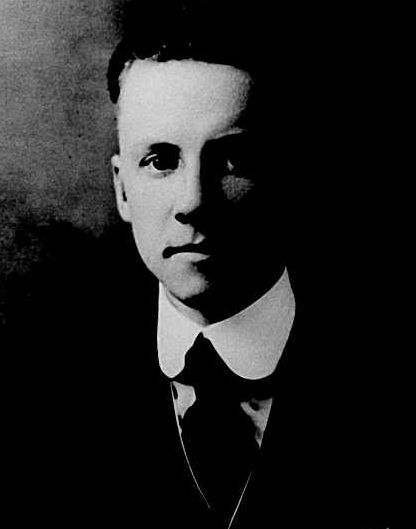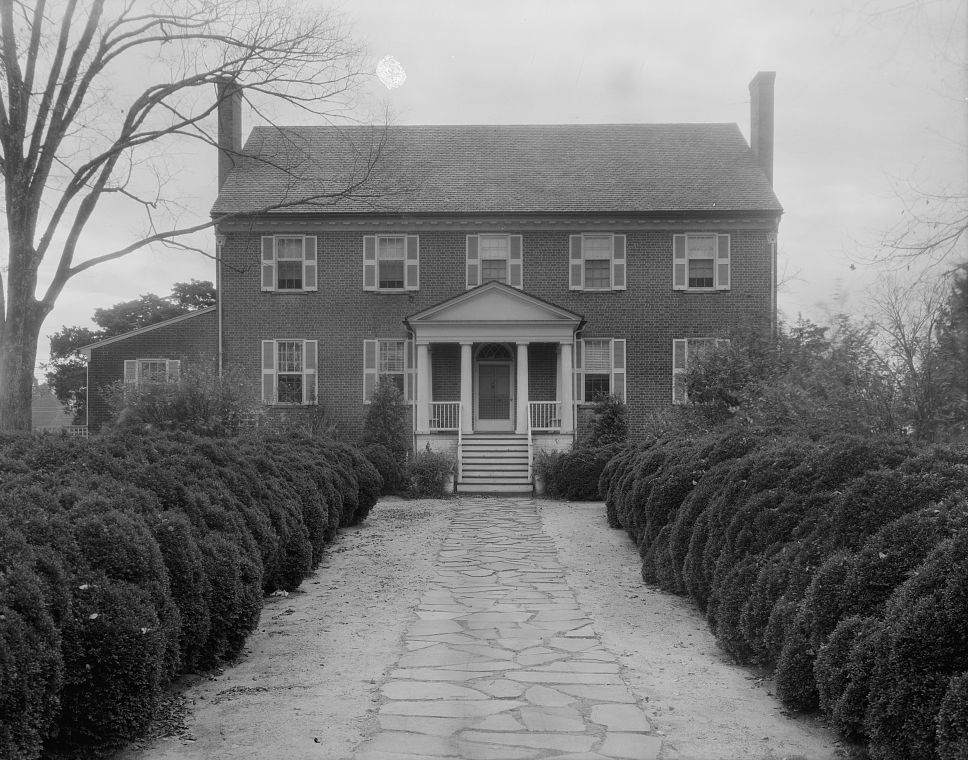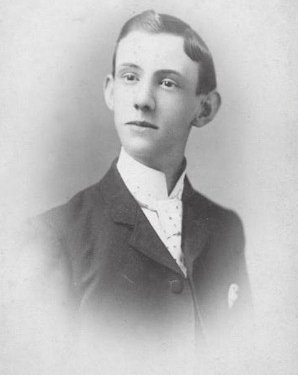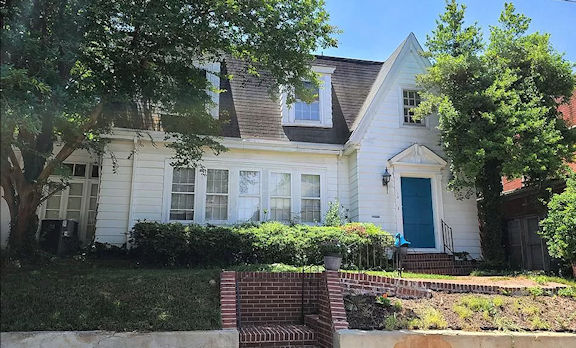The quaint home situated at 13 Chestnut Place was commissioned in 1922 by H. Lee Boatwright. The home, a quirky combination of Tudor Revival with its steeply pitched roof and asymmetrical cross-gable forming the entry, and Colonial Revival styles, the latter style defined by the broken pediment over the door and Doric columns which flank the south facing porch. The home was built on the rear of the Boatwright property and was a gift to Lee’s son John upon the occasion of his marriage to Mary Archer Glass in 1919.
 Mary was the second youngest of six children born to G. Carter and Aurelia Caldwell Glass of Lynchburg. Mr. Glass was a Lynchburg newspaper man and politician who served in the Virginia Senate in 1899 and as a delegate to the Virginia constitutional congress in 1901-1902, following which he was a state representative in 1902. Mr. Glass was instrumental in the suppression of African American votes in the early to mid 1900’s. In 1918, President Woodrow Wilson appointed him Secretary of the Treasury and was numbered among the nominees for the Democratic presidential ticket in 1920. Mr. Glass is regarded today as the father of the Federal Reserve system due to his co-sponsorship of the Glass-Steagal Act which was intended to make sure there was not a repeat of the financial conditions which had led to the Great Depression.
Mary was the second youngest of six children born to G. Carter and Aurelia Caldwell Glass of Lynchburg. Mr. Glass was a Lynchburg newspaper man and politician who served in the Virginia Senate in 1899 and as a delegate to the Virginia constitutional congress in 1901-1902, following which he was a state representative in 1902. Mr. Glass was instrumental in the suppression of African American votes in the early to mid 1900’s. In 1918, President Woodrow Wilson appointed him Secretary of the Treasury and was numbered among the nominees for the Democratic presidential ticket in 1920. Mr. Glass is regarded today as the father of the Federal Reserve system due to his co-sponsorship of the Glass-Steagal Act which was intended to make sure there was not a repeat of the financial conditions which had led to the Great Depression.
Mary was born in 1895 in Lynchburg and attended Gunston Hall, an exclusive girl’s school in Washington, D.C.. She married John Guerrant Boatwright 1919, just following his return from service during World War I. For the first few years of their marriage, they resided with John’s father at 904 Main Street.
 John was named after his grandfather, a Danville physician, and, like his father, was heavily involved in the tobacco business, which ultimately led him to a fulfill the position of president with Dibrell Brothers, while Mary continued to contribute to her father’s newspaper business. Both were active in Danville community affairs including the founding of the Danville Museum of Fine Arts and History in 1973. The Boatwright Gallery there is named for their family.
John was named after his grandfather, a Danville physician, and, like his father, was heavily involved in the tobacco business, which ultimately led him to a fulfill the position of president with Dibrell Brothers, while Mary continued to contribute to her father’s newspaper business. Both were active in Danville community affairs including the founding of the Danville Museum of Fine Arts and History in 1973. The Boatwright Gallery there is named for their family.
In 1930, John and Mary acquired nearby Dan’s Hill, an 1830’s Federal antebellum mansion, purchasing it from the original family who had owned the property for the first century of its existence. By 1935, the family had left their Chestnut Place home. Shortly thereafter, John’s uncle, Joseph Overton Boatwright took occupancy of the home.
 Joseph married Ella Wooding, the daughter of Mayor Harry Wooding in 1899. While he did dip his toes into the tobacco business, it does not seem as though Overton enjoyed the same prosperity as did his older brothers. The couple spent the first few years of their marriage at the Boatwright home on Patton Street before moving into the newly built Bagby house at 130 Sutherlin Avenue. By 1920, Overton was working as an auditor in a tobacco factory. Eventually Overton formed a partnership with Charles Graham Evans to establish the insurance brokerage of Boatwright and Evans, but the partnership ended in a nasty split in 1933 when Charles Jr. took over. For a time, during the 1920’s and into the 1930’s, the Boatwrights took rooms in the Hotel Danville. When Overton’s automobile was stolen from a parking space near the hotel in 1937, the couple decided to move closer to family and thus took occupancy of John and Mary’s home at 13 Chestnut Place.
Joseph married Ella Wooding, the daughter of Mayor Harry Wooding in 1899. While he did dip his toes into the tobacco business, it does not seem as though Overton enjoyed the same prosperity as did his older brothers. The couple spent the first few years of their marriage at the Boatwright home on Patton Street before moving into the newly built Bagby house at 130 Sutherlin Avenue. By 1920, Overton was working as an auditor in a tobacco factory. Eventually Overton formed a partnership with Charles Graham Evans to establish the insurance brokerage of Boatwright and Evans, but the partnership ended in a nasty split in 1933 when Charles Jr. took over. For a time, during the 1920’s and into the 1930’s, the Boatwrights took rooms in the Hotel Danville. When Overton’s automobile was stolen from a parking space near the hotel in 1937, the couple decided to move closer to family and thus took occupancy of John and Mary’s home at 13 Chestnut Place.
 When Overton died in November of 1940, he made a provision in his will for a memorial to be erected in honor of his father-in-law, Mayor Harry Wooding. When Overton’s estate failed to produce the requisite funds for the enterprise, the mission was taken up by the Exchange Club of Danville, and in July of 1942 the statue was presented to the city and erected on the steps of the municipal building where it stands to this day.
When Overton died in November of 1940, he made a provision in his will for a memorial to be erected in honor of his father-in-law, Mayor Harry Wooding. When Overton’s estate failed to produce the requisite funds for the enterprise, the mission was taken up by the Exchange Club of Danville, and in July of 1942 the statue was presented to the city and erected on the steps of the municipal building where it stands to this day.
The home was subsequently purchased by Mrs. Boatwright’s nephew who, with his new bride, had been residing with the Boatwrights during the month’s prior to Overton’s death. Harry Wooding Spencer had married Frances Kipps that previous August, and the home was to be there’s.
Frances, born in Japan in 1917, is credited for developing the Chrismons tree, a world-wide tradition which Mrs. Spencer originated at Danville’s Lutheran Church of the Ascension. The Spencers lived in the house until about 1984, when, some ten years after the death of her husband, Frances relocated to Tennessee, ending a 75-year tradition of Boatwright-Wooding family ownership.
Sources include:
Danville Historical Society Holiday Tour Archives, 2011
Highland Recorder; Monterey, VA; “Death of Mr. John R. Pace”; 10 October 1893
The Bee, “H.L. Boatwright, Pioneer of Danville Leaf Mart Dies” 23 Jan 1935
The Bee, “Boatwright Car is Recovered…” 19 Jan 1937
The Bee, “J.O. Boatwright Estate Valued…” 26 Nov 1940
The Bee, “Memorial to Catp. Wooding…” 6 June 1942
If Streets Could Talk, Lee Wayland, pg. 61
Gary Grant
City Directories, Census, Death, and Immigration/Passport records.

excellent post…minimizes the distance to the historical figures who left their marks on Danville…